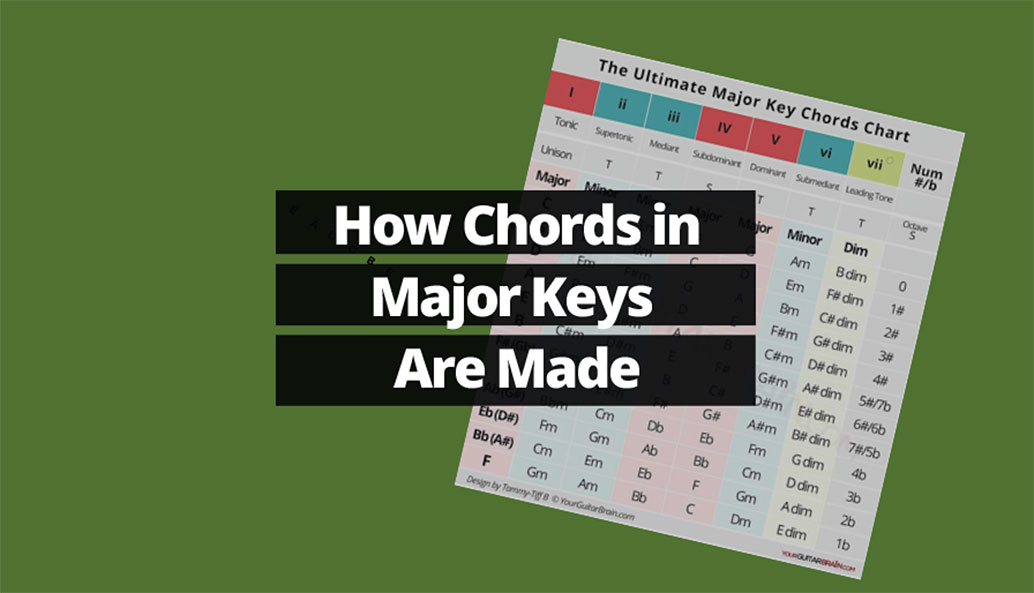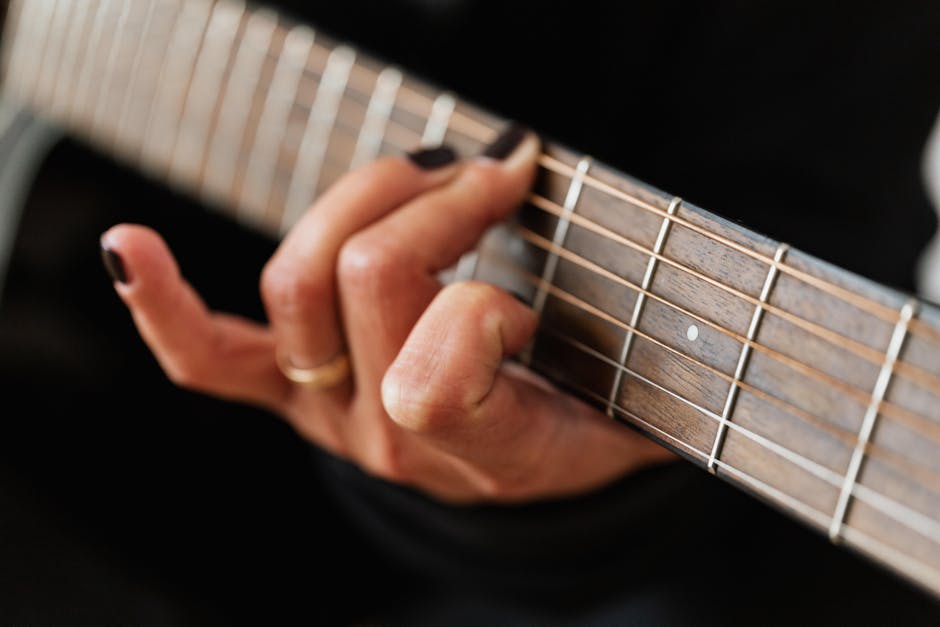So you’ve mastered air guitar and are ready to move on to the real deal – major chords on the guitar! Fear not, aspiring rockstar, because we’ve got your back with this step-by-step guide to becoming a chord-slinging master. Get ready to rock and roll your way to musical greatness with our hilarious and handy tips for mastering major chords on the guitar.
Contents
- 1 Understanding the Structure of Major Chords
- 2 Exploring the Guitar Fretboard: Finding Major Chord Shapes
- 3 The Role of Finger Placement in Creating Clear Major Chords
- 4 Strumming Patterns and Rhythms for Major Chords
- 5 Transitioning Between Major Chords Smoothly
- 6 Incorporating Major Chords into Your Playing: Practice Tips
- 7 Overcoming Common Challenges with Major Chords on the Guitar
- 8 FAQs
- 9 Rock On, Major Master!
Understanding the Structure of Major Chords
So you want to understand the structure of major chords, huh? Well buckle up, because we’re about to dive into the fascinating world of music theory. But don’t worry, it’s not rocket science…although sometimes it might feel like it!
Major chords are like the superheroes of the music world. They’re strong, powerful, and they always save the day (or at least the song). But what makes up a major chord, you ask? Let me break it down for you:
- Root Note: This is the starting point of the chord, the one that gives it its name. Without the root note, the chord would be lost…like a ship at sea without a compass.
- Third: This note is what gives the chord its major-ness. It’s like the secret sauce that makes a major chord sound happy and bright. Without it, the chord would be as dull as a rainy day.
- Fifth: This note adds stability and strength to the chord. It’s like the rock that holds everything together, keeping the chord from falling apart like a house of cards.
Put these three notes together and you’ve got yourself a major chord. Isn’t that magical? It’s like a musical recipe that never fails to bring a smile to your face…or at least a tap to your foot. So next time you hear a major chord in a song, you’ll know exactly what makes it tick. Happy chord hunting!
Exploring the Guitar Fretboard: Finding Major Chord Shapes
So you’ve mastered strumming a few simple chords on your guitar and now you’re ready to take your playing to the next level by exploring the vast expanse of the fretboard. Fear not, brave guitarist, for I am here to guide you on your quest to discover the elusive major chord shapes hidden within the mysterious world of frets and strings.
First, let us embark on a journey to find the majestic G major chord shape. Begin by placing your index finger on the second fret of the A string. Next, place your middle finger on the third fret of the low E string, and your ring finger on the third fret of the high E string. Strum all six strings proudly and bask in the glory of the G major chord.
Next, we shall seek out the regal C major chord shape. Place your ring finger on the third fret of the A string, your middle finger on the second fret of the D string, and your index finger on the first fret of the B string. Strum only the bottom five strings and let the sweet sounds of the C major chord serenade your ears.
Now that you have unlocked the secrets of the G and C major chord shapes, feel free to continue your exploration of the guitar fretboard. Who knows what other wondrous chord shapes await you in the realm of frets and strings? Remember, brave guitarist, the fretboard is your oyster – so go forth and conquer!

The Role of Finger Placement in Creating Clear Major Chords
When it comes to playing major chords on the guitar, finger placement is key (pun intended!). In order to create clear and crisp major chords, you need to pay attention to where you place your fingers on the fretboard.
One important thing to remember is to use the tips of your fingers to press down on the strings. This allows for better precision and accuracy, resulting in a more harmonious sound. Whether you’re strumming your favorite pop song or shredding a rock anthem, proper finger placement is essential.
Here are a few tips to keep in mind:
- Place your fingers close to the frets to minimize buzzing and ensure a clean sound.
- Make sure your fingers are arched, rather than flat, to prevent muting adjacent strings.
- Use the correct fingers for each chord shape, as indicated in chord diagrams or tablature.
With a little practice and attention to detail, you’ll be playing major chords like a pro in no time. So next time you pick up your guitar, remember: finger placement is the key to unlocking those clear, beautiful major chords!

Strumming Patterns and Rhythms for Major Chords
Major chords are the bread and butter of any guitar player’s repertoire, but sometimes playing them can feel a bit bland. Spice up your chord progressions with some killer strumming patterns and rhythms!
One of my favorite strumming patterns for major chords is the **down up down up**. It’s like the chicken dance of strumming patterns – simple yet effective. You can also try the **down down up up down up** for a more syncopated feel that will make your chords pop.
Feeling fancy? Give the **syncopated strum** a whirl. It’s all about breaking the rules and mixing up the order of your strums to create a unique rhythm that will have everyone tapping their feet. Trust me, once you master the syncopated strum, you’ll feel like a rockstar.
Don’t be afraid to experiment with different strumming patterns and rhythms until you find the one that fits your style. Remember, there are no wrong answers when it comes to music – just endless possibilities for creativity and fun. So grab your guitar, pick a major chord, and strum away to your heart’s content!

Transitioning Between Major Chords Smoothly
One of the keys to mastering the guitar is being able to transition between major chords smoothly. It’s like trying to sneak past a sleeping dragon without waking it – you have to move carefully and quietly, or else face the consequences!
To ensure your chord transitions are as seamless as possible, try these tips:
– **Practice, practice, practice**: Just like a ninja training in the shadows, you must dedicate time to perfecting your chord changes. The more you practice, the more natural the transitions will become.
– **Use the buddy system**: Pair up chords that share similar finger positioning to make switching easier. Think of them as two best friends holding hands – they just flow naturally from one to the other.
– **Mind your fingers**: Keep those digits nimble and light on the fretboard. Don’t let them stomp around like a herd of elephants – finesse is key here.
– **Stay calm and collected**: Don’t panic if you hit a wrong note or fumble a chord change. Remember, even the most skilled guitarists make mistakes. Embrace the journey, and laugh off any slip-ups along the way.
With these tips in mind, you’ll be transitioning between major chords like a seasoned pro in no time. Just remember, the key is to approach it with patience, persistence, and a dash of humor. Happy strumming!
Incorporating Major Chords into Your Playing: Practice Tips
So you’ve finally decided to take the plunge and incorporate major chords into your playing. Congratulations! Major chords are like the sparkling unicorns of the music world - beautiful, majestic, and just a little bit elusive. But fear not, with a little practice and determination, you’ll be incorporating major chords into your playing like a boss in no time.
Here are some practice tips to help you along your major chord journey:
- Start slow: Major chords can be a bit tricky at first, so don’t be afraid to take it slow. Practice each major chord one at a time until you feel comfortable moving between them.
- Use a metronome: Keeping a steady beat is crucial when incorporating major chords into your playing. Use a metronome to help you stay in time and build your muscle memory.
- Experiment with different voicings: Major chords can be played in a variety of different positions on the fretboard. Don’t be afraid to experiment with different voicings to find the ones that sound best to you.
Remember, Rome wasn’t built in a day, and neither was Eric Clapton. Keep practicing, stay patient, and soon you’ll be incorporating major chords into your playing with ease and finesse. And who knows, maybe one day you’ll be the next guitar hero of your generation!
Overcoming Common Challenges with Major Chords on the Guitar
So you’ve mastered the art of playing major chords on the guitar, but you’re still facing some common challenges. Don’t fret (pun intended), we’ve got you covered with some tips and tricks to help you overcome these obstacles!
One common issue guitarists face when playing major chords is getting all the notes to ring out clearly. To tackle this problem, make sure you’re using proper finger placement and apply just the right amount of pressure. Remember to keep your fingers close to the frets for optimal sound and experiment with different hand positions until you find the sweet spot.
Another challenge many guitarists encounter is transitioning between major chords smoothly. To improve your chord changes, practice switching between chords slowly at first and gradually increase your speed. Focus on keeping your fingers relaxed and use a metronome to help you stay in time. Before you know it, you’ll be switching between major chords like a pro!
Lastly, don’t forget to have fun and experiment with different voicings and variations of major chords. Get creative and try playing them in different positions on the neck or adding in some embellishments for a unique sound. The more you explore and push yourself out of your comfort zone, the more your skills will improve. Keep strumming and remember, practice makes perfect!
FAQs
What are major chords and how do they work?
Well, major chords are like the superheroes of the music world. They are made up of a root note, a major third, and a perfect fifth, which when combined, create a harmonious and pleasing sound. Think of them as the Avengers of the guitar fretboard.
Why is it important to master major chords?
Mastering major chords is like unlocking a secret code to the musical universe. They are the foundation of countless songs and knowing how to play them opens up a world of possibilities for your playing. Plus, chicks dig guys who can play a killer G major chord.
What is the best way to practice major chords?
Practice, practice, practice! Just like anything worth mastering, repetition is key. Start by focusing on one major chord at a time and really nail down the finger positioning and strumming technique. And don’t be afraid to make weird faces while you play – it’s all part of the process.
Any tips for transitioning between major chords smoothly?
Ah, the age-old struggle of the amateur guitarist. The key to smooth chord transitions is to practice switching between chords in a steady and controlled manner. Start slow, focus on one transition at a time, and before you know it, you’ll be switching between major chords like a ninja.
How can I take my major chord playing to the next level?
If you want to take your major chord playing to the next level, experiment with different strumming patterns, add in some fancy embellishments, or try playing the chords in different positions on the fretboard. And remember, confidence is key – so play those major chords like you own the stage!
Rock On, Major Master!
Congratulations, you’ve officially mastered major chords on the guitar! Now go forth and serenade your friends, family, and neighbors (or maybe just your pet rock) with your newfound skills. Remember, practice makes perfect, so keep strumming those chords and soon enough, you’ll be playing like a rock star. And who knows, maybe one day you’ll be headlining at Madison Square Garden. Until then, keep jamming and keep rocking out!



